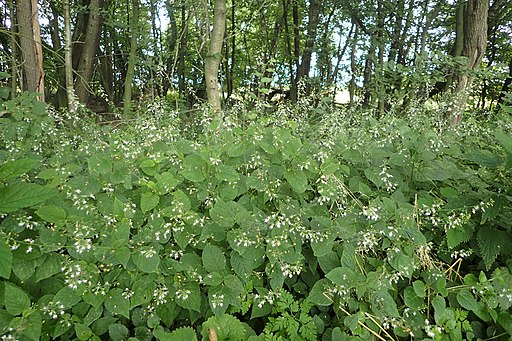
Enchanter’s Nightshade
Circaea lutetiana subsp. canadenis
By Linda Shuster, WORC Member
Despite its common name, Enchanter’s nightshade is not a member of the nightshade (Solanaceae) family. It is a member of the evening primrose (Onagraceae) family. The genus name, Circaea, is derived from the name of the enchantress of Greek mythology, Circe. It is said that Circe used the plant in her potions. The species name is derived from the Latin name for Paris, Lutetia, which at one time was known as the Witch City.
Enchanter’s nightshade grows to a height of 1–3’. The leaves are 2.5 to 5” in length and are ovate in shape with a pointed tip. They are slightly toothed and arranged in an opposite pattern with size decreasing toward the top of the stem. The plant produces very small (less than ¼”) white flowers in terminal clusters. It is one of only a few plants that has flowers with just 2 petals. The plant flowers from June to August. The fruit is a small oval shaped capsule containing a single seed. It is covered with stiff hairs that allow it to stick to birds and mammals, including humans. It propagates through both these seeds and rhizomes. From a distance the flowers are not showy, but up close they are a pretty little flower.
 Enchanter’s nightshade is found in shady rich woods. It is native to 48 U.S. states (USDA). The Michigan Natural Features Inventory lists it as a forb characteristic of Mesic Southern Forest, which is a natural community that was prevalent or likely prevalent in many counties in Lower Michigan, including Kent County. It has been observed in nearly all of the Lower Peninsula counties and most of the Upper Peninsula counties according to the University of Michigan Herbarium. Michigan has another species of this plant, Small Enchanter’s nightshade (Circaea alpina). As the name suggests, it is smaller than Enchanter’s nightshade and is found in wet environments, such as swamps and moist depressions in forests.
Enchanter’s nightshade is found in shady rich woods. It is native to 48 U.S. states (USDA). The Michigan Natural Features Inventory lists it as a forb characteristic of Mesic Southern Forest, which is a natural community that was prevalent or likely prevalent in many counties in Lower Michigan, including Kent County. It has been observed in nearly all of the Lower Peninsula counties and most of the Upper Peninsula counties according to the University of Michigan Herbarium. Michigan has another species of this plant, Small Enchanter’s nightshade (Circaea alpina). As the name suggests, it is smaller than Enchanter’s nightshade and is found in wet environments, such as swamps and moist depressions in forests.
Dr. John Hilty states that the nectar and pollen of the flowers attracts small bees and flies, including Halictid bees, little carpenter bees, Syrphid flies, and bee flies. He further notes that the caterpillars of the Enchanter’s Cosmet are leaf-miners on the foliage.
 Enchanter’s nightshade can become weedy in the garden, however, it is easily controlled. I discovered this plant growing naturally in my yard. Although not as showy as some of our other natives, this plant is worth considering for your garden as it is one of the few shade tolerant natives that blooms in the summer. Alternatively, watch for its white blooms when you are in the woods in the summer. Check out this video of Enchanter’s nightshade in the forest.
Enchanter’s nightshade can become weedy in the garden, however, it is easily controlled. I discovered this plant growing naturally in my yard. Although not as showy as some of our other natives, this plant is worth considering for your garden as it is one of the few shade tolerant natives that blooms in the summer. Alternatively, watch for its white blooms when you are in the woods in the summer. Check out this video of Enchanter’s nightshade in the forest.
Photo credits:
Top: Circaea lutetiana in Kukinia near Ustronie Morskie, NW Poland by Krzysztof Ziarnek, Kenraiz; License
Middle: Circaea canadensis in Skaneateles, NY by Randy Nonenmacher; License
Bottom: Enchanter’s nightshade in early Spring by Linda Shuster
Sources
- National Audubon Society (2001). Field Guide to Wildflowers (rev ed.). Alfred Knopf.
- Cohen, J.G., Kost, M.A., Slaughter, B.S., & Albert, D.A. (2015). A Field Guide to the Natural Communities of Michigan. Michigan State University Press.
- Friends of the Wildflower Garden, Inc: https://www.friendsofthewildflowergarden.org/pages/plants/enchanters.html
- University of Michigan Herbarium: https://michiganflora.net/
- Hilty, J. Illinois Wildflowers: https://www.illinoiswildflowers.info/woodland/plants/enchanter_ns.htm
- Minnesota Wildflowers: https://www.minnesotawildflowers.info/flower/enchanters-nightshade
- USDA Natural Resources Conservation Service: https://plants.usda.gov/core/profile?symbol=CILU
